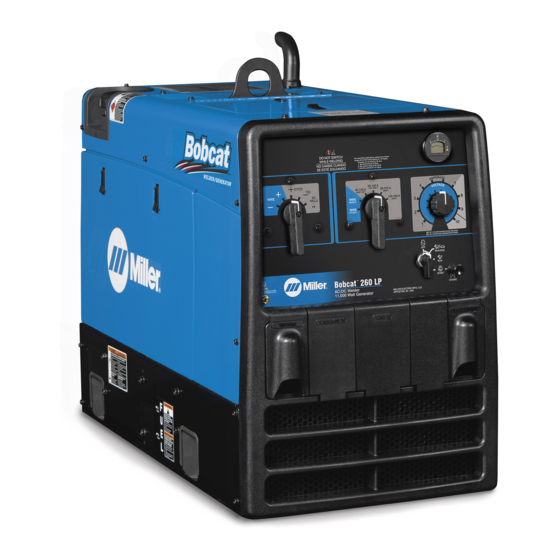Miller Bobcat 250 Manuel d'application - Page 6
Parcourez en ligne ou téléchargez le pdf Manuel d'application pour {nom_de_la_catégorie} Miller Bobcat 250. Miller Bobcat 250 16 pages. Generator power

2. How Much Generator Power Do You Need?
EXAMPLE WORKSHEET
Column A
TOOL OR
STARTING
APPLIANCE
WATTS
1. Refrigerator
2. Sump Pump
3. Table Saw
4.
5.
6.
7.
TOTAL RUNNING WATTS =
With this example you need
a generator that produces
at least 3,300 total running
watts and 7,800 total watts.
EXAMPLE WORKSHEET
Column A
TOOL OR
STARTING
APPLIANCE
WATTS
1.
2.
3.
4.
5.
6.
7.
TOTAL RUNNING WATTS =
I need a generator that
produces at least ________
total running watts and
________ total watts.
Page 2
Column B
RUNNING
WATTS
2,200
−
700
1,300
800
6,300
1,800
3,300
TOTAL RUNNING WATTS
TOTAL WATTS NEEDED
Column B
RUNNING
WATTS
−
TOTAL RUNNING WATTS
TOTAL WATTS NEEDED
Column C
ADDITIONAL
STARTING
WATTS
1,500
=
500
4,500
4,500
HIGHEST
ADDITIONAL
STARTING WATTS
3,300
+
7,800
=
Column C
ADDITIONAL
STARTING
WATTS
=
HIGHEST
ADDITIONAL
STARTING WATTS
(COLUMN C)
+
=
Use this easy reference to
determine the generator size
you need. To select a genera-
tor with enough power output
in watts, add the watts for the
items you want to simulta-
neously run. Tools and ap-
pliances with induction motors
may require 3 − 7 times the
listed wattage when starting.
All data listed is approxi-
mate—check your tool/ap-
pliance for specific wattage
requirements. Your actual re-
quirements will vary (see Sec-
tions 4 and 7).
This worksheet will focus on
determining your starting and
running watt needs.
Amount of generator power
you need depends on your
power requirements. General-
ly, a higher-wattage generator
lets you power more items at
once.
1 Select the items you wish
to power at the same time.
Using the chart in Section
3, fill in the starting watts
(Column A) and running
watts (Column B)
requirements.
2 Add all the items in the
RUNNING WATTS column
(Column B) to determine
total running watts. Enter
the total in the TOTAL
RUNNING WATTS boxes.
3 Subtract RUNNING
WATTS (Column B) from
STARTING WATTS
(Column A). Enter the
results in the
ADDITIONAL STARTING
WATTS column (Column
C). Select the ONE
INDIVIDUAL ITEM with
the highest number of
ADDITIONAL STARTING
WATTS. Take this ONE
NUMBER, add it to your
TOTAL RUNNING
WATTS, and enter the
total in the TOTAL WATTS
NEEDED box.
